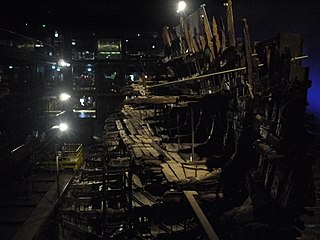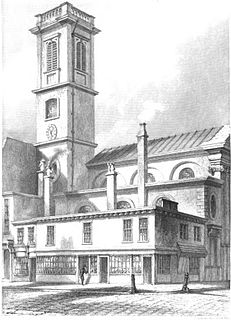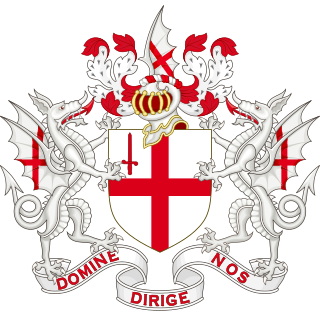Sir Thomas Curtis (sometimes Thomas Curteys; d. 27 Nov 1559) was an English pewterer and politician who was elected Lord Mayor of London in 1556.

The Lord Mayor of London is the City of London's mayor and leader of the City of London Corporation. Within the City, the Lord Mayor is accorded precedence over all individuals except the sovereign and retains various traditional powers, rights and privileges, including the title and style The Right Honourable the Lord Mayor of London.
Born circa 1502 to John Curtis of Enfield, Middlesex, [1] Thomas Curtis was one of the most important pewterers of his time, and served as warden of the Worshipful Company of Pewterers in 1524 and master of the company in 1538, 1539, 1545, and 1546. [2] His touch mark appears on much of the pewter later found on the Mary Rose , as well as about thirty percent of the pewter found in a shipwreck near Punta Cana, lost en route to the Americas. [3] [4] [5]

Middlesex is an ancient county in southeast England. It is now entirely within the wider urbanised area of London. Its area is now also mostly within the ceremonial county of Greater London, with small sections in other neighbouring ceremonial counties. It was established in the Anglo-Saxon system from the territory of the Middle Saxons, and existed as an official unit until 1965. The historic county includes land stretching north of the River Thames from 17 miles (27 km) west to 3 miles (5 km) east of the City of London with the rivers Colne and Lea and a ridge of hills as the other boundaries. The largely low-lying county, dominated by clay in its north and alluvium on gravel in its south, was the second smallest county by area in 1831.

The Worshipful Company of Pewterers is one of the 110 Livery Companies of the City of London. It ranks 16th in the order of precedence of City Livery Companies and has existed since at least 1348.

The Mary Rose is a carrack-type warship of the English Tudor navy of King Henry VIII. After serving for 33 years in several wars against France, Scotland, and Brittany and after being substantially rebuilt in 1536, she saw her last action on 19 July 1545. While leading the attack on the galleys of a French invasion fleet, she sank in the Solent, the straits north of the Isle of Wight.
His public career started inauspiciously; he was elected as one of the Sheriffs of the City of London in 1546 against his will, and contested his election up to the day he was sworn in. [1] At the end of his term, he was elected one of the MPs for London. [1] He left Parliament in 1551 to become alderman of Farringdon Within. [1] At that time, he was still a member of the Pewterer's Company, which brought him into conflict with the customary requirement for aldermen of London to be members of one of the Great Twelve City Livery Companies. [6] He was sent to Newgate Prison and fined for his refusal to comply, after which he became a fishmonger. He was elected mayor of London in 1556. The only other pewterer to become mayor of London, John Fryer, likewise became a fishmonger.
Two Sheriffs are elected annually for the City of London by the Liverymen of the City Livery Companies. Today Sheriffs have only nominal duties, but previously had important judicial responsibilities. They have attended the Justices at the Central Criminal Court, Old Bailey since its original role as the Court for the City and Middlesex.

Farringdon Within is one of the 25 wards of the City of London, the historic and financial centre of London. The ward covers an area from Blackfriars station in the south to Barbican station in the north.

Newgate Prison was a prison at the corner of Newgate Street and Old Bailey just inside the City of London, England, originally at the site of Newgate, a gate in the Roman London Wall. Built in the 12th century and demolished in 1904, the prison was extended and rebuilt many times, and remained in use for over 700 years, from 1188 to 1902.
Curtis died on 27 November 1559. His son predeceased him, leaving a granddaughter, Anne, as heir. She married the mercenary Thomas Stukley; her inheritance launched Stukley's public life. [7] Curtis was buried at St Dionis Backchurch on 6 December 1559. [1]

Thomas Stucley, also written Stukeley or Stukley and known as The Lusty Stucley, was an English mercenary who fought in France, Ireland, and at the Battle of Lepanto (1571) and was killed at the Battle of Alcazar (1578) fighting the Moors. He was a Roman Catholic recusant and a rebel against the Protestant Queen Elizabeth I.

St Dionis Backchurch was a parish church in the Langbourn ward of the City of London. Of medieval origin, it was rebuilt after the Great Fire of London to the designs of Christopher Wren and demolished in 1878.


